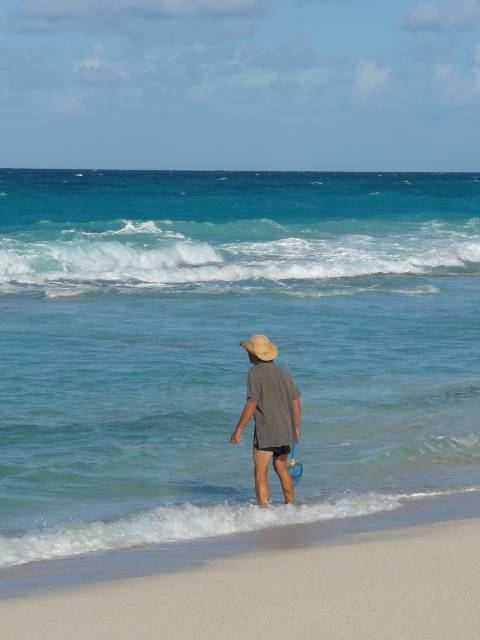Warderick Wells to Georgetown, Exuma Islands, Bahamas
12th February - 26th March 2009
With the help of plumbing supplies from the Park, Phil fashioned a cap for the leaking tube, complete with hose barb attached. The whole thing was amply coated in sealant. The electric cable to the transducer was then fed through a long hose. In the case of a catastrophic failure the plan was to cut the cable, attach the hose to the tube's new cap making a watertight seal, allowing us to direct any ingress of water back overboard, above the waterline. It was a lot of work for a contraption we hoped never to use but, as always, we were of the view that it was better to be prepared for the worst.
Once we had taken these precautions, it was time to attempt create an underwater seal around the plastic transducer. It appeared that corrosion was taking place between the steel tube and the plastic mounting. We consulted for ideas with Tom and Andrew at the Park, both experienced divers, who had spent plenty of time making underwater repairs. Our first attempt to make the seal was using marine sealant. The dive gear was set up, Phil donned his wetsuit and set off under the water, a tube of 5200 in hand. As we had feared, 5200 wouldn't stick under water (except to wet-suit material!) and was quickly washed away in the current. A second attempt was made using Marine Tex repair epoxy. Again this material stubbornly refused to stick underwater to anything except Phil's expensive wet suit (aargh).
In the end the underwater repair had to wait until Georgetown, where we made a plea on the Cruiser's VHF net for ideas for a suitable repair material. It turned out our good friends George and Julie on Seaquel, who had introduced us to the Ocean Cruising Club, had just the right thing on board their yacht. Conveniently anchored right in front of Anju, George called to suggest a material called Waterweld and lent us some he had on board. This material consisted of two coloured putty which, once mixed, had a useable life of two minutes before hardening. We certainly couldn't hang around! Phil was ready in the water, Christine mixed the putty in a plastic bag in the dinghy and quickly passed it over to the waiting diver. Phil dived quickly down to the transducer, applied the putty within its two minute lifespan and surfaced again. It seemed to be working. Another dive a couple of days later confirmed this. It seemed we had a temporary fix for the problem, until we could haul out back in Florida.
Other OCC friends also came to our rescue. During a big blow up in Warderick Wells, we'd been awakened at 1.30 am by a loud bang, followed by a horrible grinding noise, which could only be coming from "Stormin' Norman" our trusty Air Marine wind generator. We hurried on deck in our nightwear, quickly starting to shiver in the brisk 30 knots of northerly wind. It seemed poor Norman had lost one of his three blades. The repair wouldn't have been difficult if we only had a spare set of blades. A new set of blades could easily be located in the States but how would they get to a small island in a Nature Reserve in the Bahamas? Our friends Chris and Vivian had already left the States. Suddenly it dawned on us that George and Nancy would be leaving from Florida in around 10 days time, on their yacht Trumpeter, to cross to the Bahamas. Thank heavens for Skype, which allowed us to order the blades from Arizona for shipment to their home in time for their departure.
The next tricky problem was that by the time the strong winds let up enough for Trumpeter to make the crossing, we were already in Georgetown. Trumpeter was bound direct from Eleuthera to the Jumentos Cays, far south of our location. It seemed our paths were not to cross for a while. In true cruising community style, another boat, Syringa, volunteered to deliver the blades to Georgetown for George and Nancy. Only minutes after Syringa's arrival in the anchorage, Norman was repaired and generating amps again! It had been frustrating to sit aboard listening to the howling wind, knowing that we could have been generating plenty of power, if only our wind generator had been working. We were certainly delighted and grateful to everyone involved to receive the new blades so quickly.
Naturally we all had to get together to catch up and play games. Chris and Vivian were delighted to have George and Julie take the dogs for their early morning walk on the beach each day.
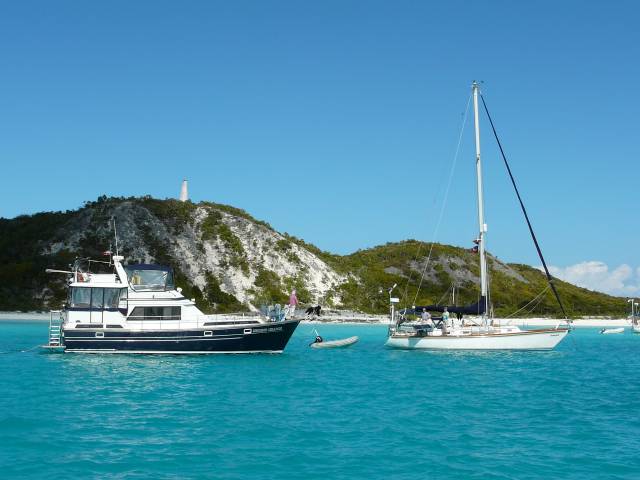
Second Chance and Seaquel finally meet
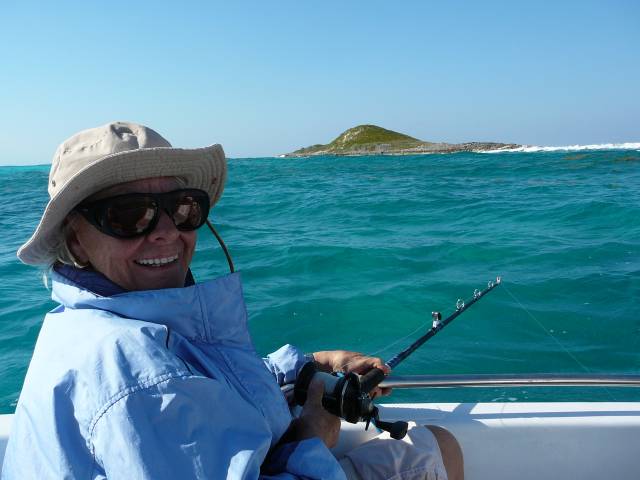
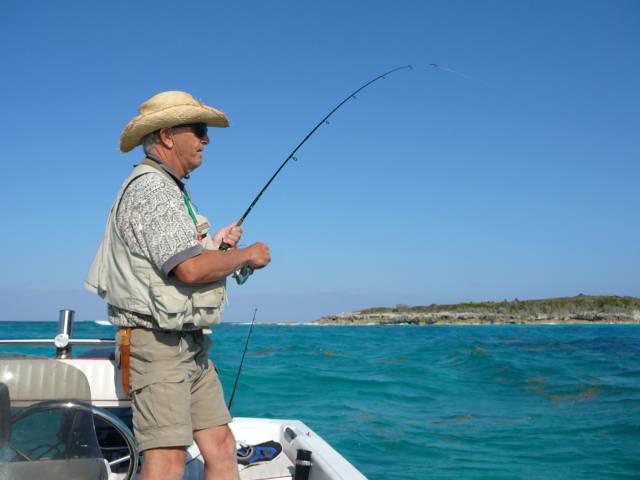
Looks like chicken for dinner again!
Suddenly it was time for the Annual Georgetown Cruisers' Regatta. The whole shindig kicked off with a parade of boats through the harbour. Anju wouldn't be taking part due to the shallow depths the boats would be crossing (one boat did actually run aground). We were happy to lend our neighbours Gail and Bob on Star our ready-strung signal flags, allowing them to dress their ship for the parade. Before long we were signed up as Star's crew for the two races later in the week.
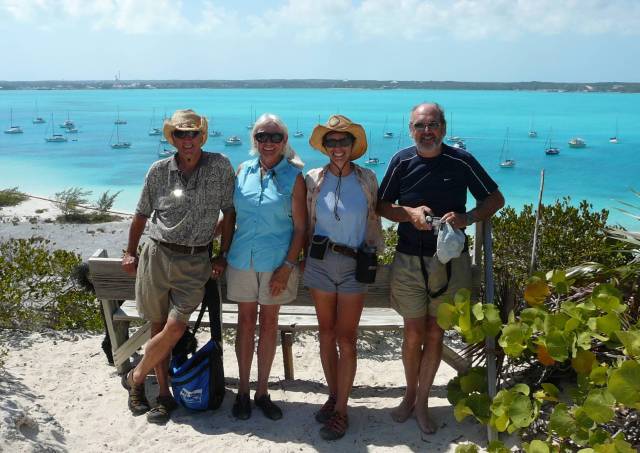
We can see our house from up here!
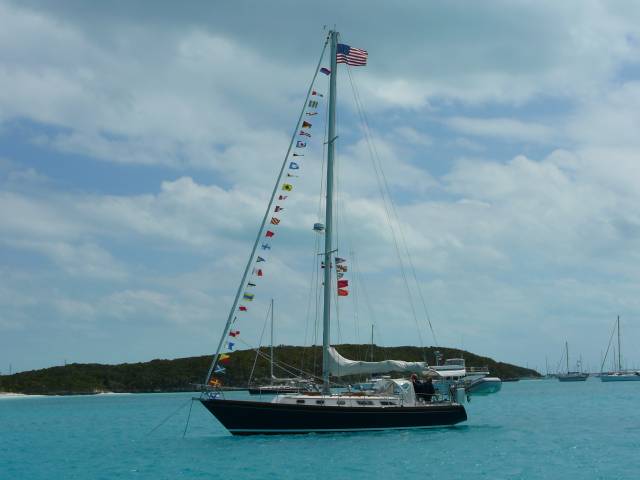
Star looking beautiful dressed in Anju's flags ready for the parade.
The silliness continued through the week with a sand sculpture contest, where our race skipper Gail surpassed herself. A treasure hunt (known in American as a Scavenger Hunt) was held in the harbour with teams in dinghies frantically racing around in search of a bizarre selection of items. A coconut harvest took teams in dinghies powered only with flippers in pursuit of 700 coconuts released into the water.
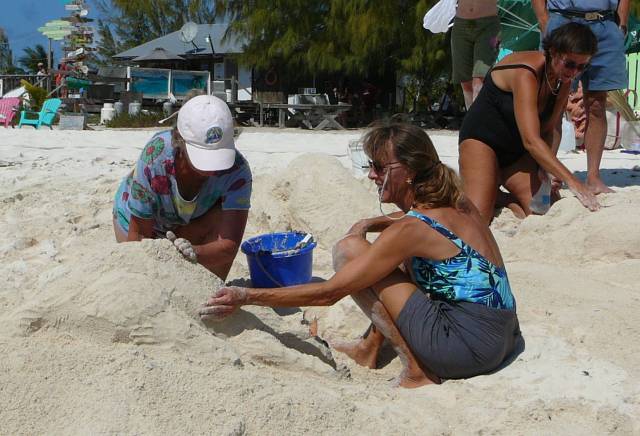
Gail hard at work on her sand masterpiece
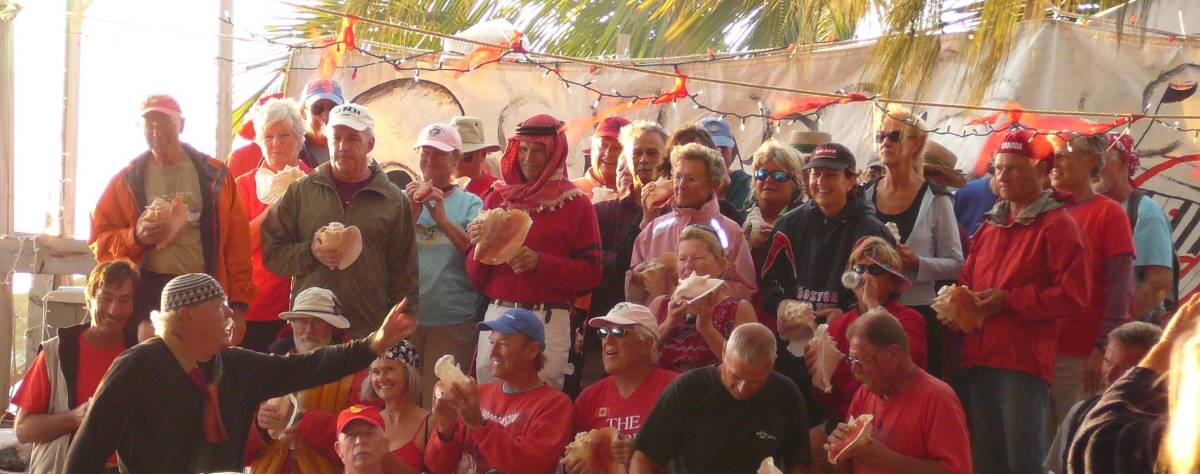
Conductor Bill readies his amazing Conch Horn Orchestra for their No-Talent Show Performance.
Once the race was underway, the pressure was on and outside the harbour conditions were a little choppy, as we sailed hard on the wind. It was only once we rounded the windward mark at the south end of the island and hit the downwind straight to the finish line, that we finally had time to eat our picnic lunch. The final leg proved frustrating as the wind dropped right off and the closely grouped boats ghosted slowly through the harbour. We weren't destined to win a prize in this race (even in the fishing or baking categories!) but had another chance to prove ourselves two days later in the In-Harbour Race.
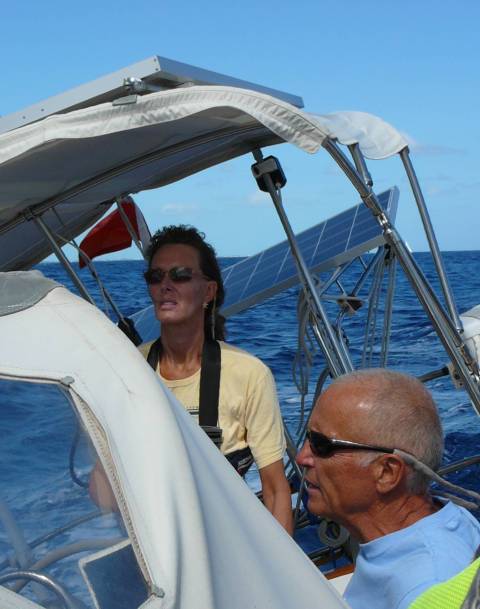
Skipper Gail concentrating at the helm, while Bob watched our rivals.
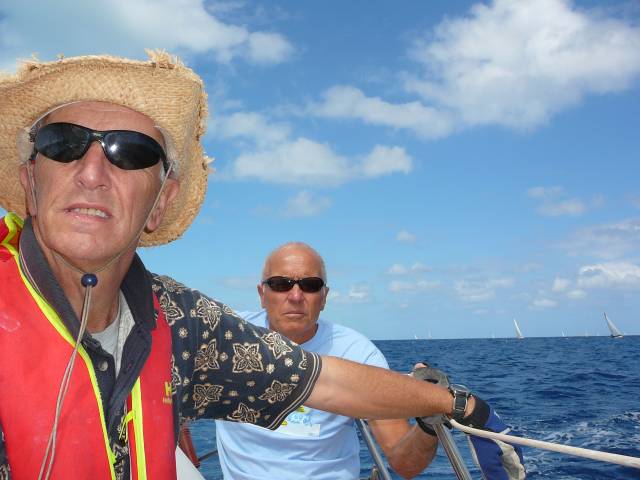
It's a serious business racing!
The course was triangular and we were going well. A mess up at the first gybe around the downwind mark cost us dear, but our skipper was determined. Our second lap of the course was much slicker and our close rival boat helped us out again by missing the mark and having to turn back to pass it. We felt we were certainly in with a chance of a prize as we crossed the line.
Our final participation in the Regatta was at the Trivia Competition. Team Anju was paired with Team Tilt, Kris and Craig, for the event. Considering we'd never met before, we worked pretty well as a team. The questions were brain-achingly hard as evidence by the fact that the results were calculated by the number of questions you had wrong, not correct. No prizes for "Tilted Anju" but we certainly didn't disgrace ourselves.
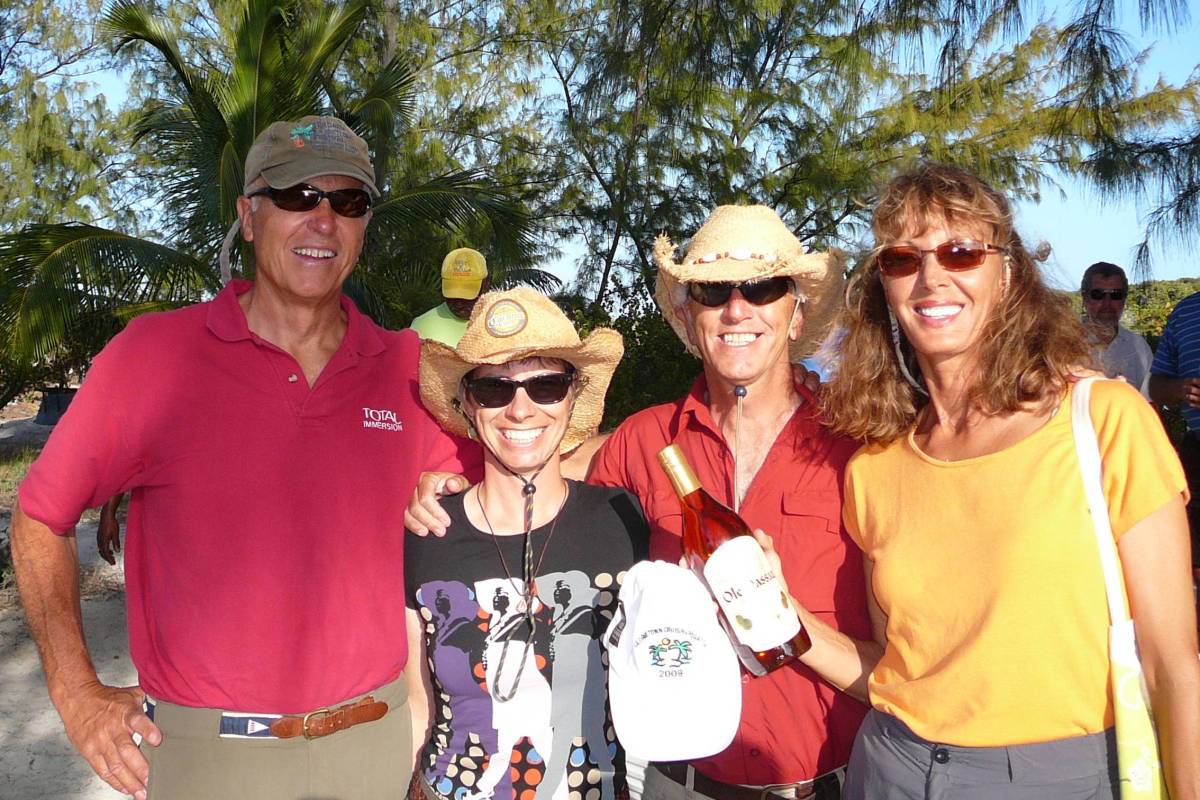
Team Star winners of "Best Race Start" and Second Place
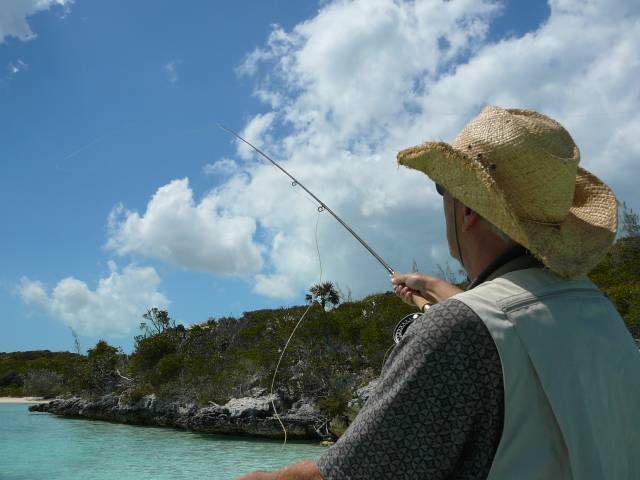
Phil tries to tempt the Bonefish
The weather-enforced in-harbour time combined with a wonderful sour-dough bread starter provided by Judy at the Exuma Park enabled Christine to perfect her baking skills. Finally a loaf had been produced aboard Anju which looked like bread, tasted like bread and felt like bread (rather than a brick!).
A wonderful cookie recipe from Gail on Star was also perfected. We certainly wouldn't starve, even if the bumpy, wet, uncomfortable dinghy trip to the shops in town was avoided at all cost.
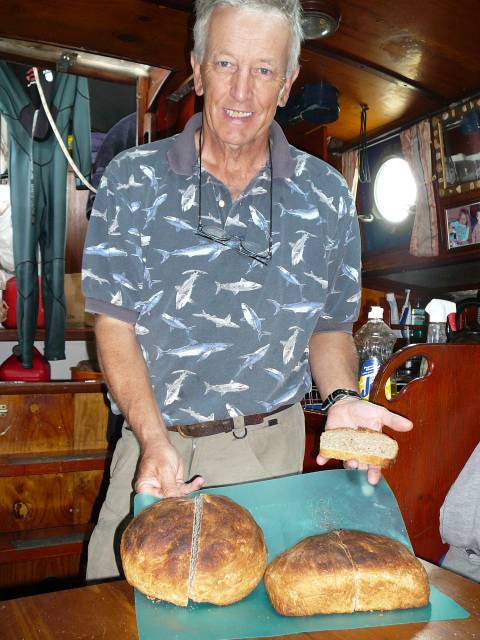
So, where did you sneak off to buy this bread???
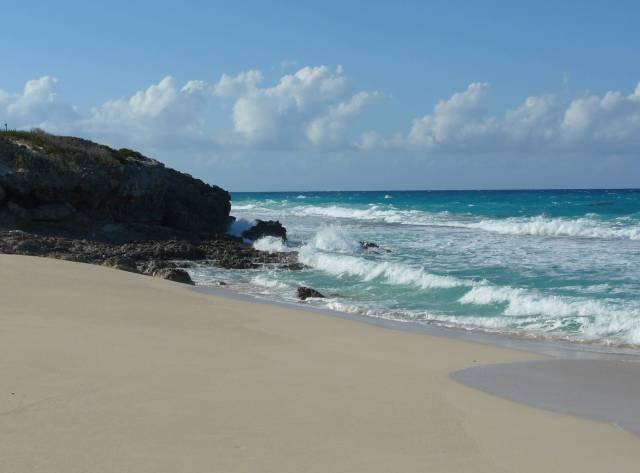
Phil scans the incoming rollers for treasure
